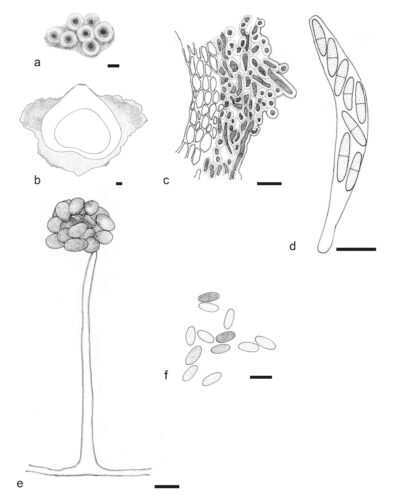Fungalpedia – Note 301, Lasionectriella
Lasionectriella Lechat & J. Fourn.
Citation when using this entry: Perera et al. 2024 (in prep) – Fungalpedia, genera described in 2016.
Index Fungorum, Facesoffungi, MycoBank, GenBank, Fig. 1
Classification: Bionectriaceae, Hypocreales, Hypocreomycetidae, Sordariomycetes, Pezizomycotina, Ascomycota, Fungi
Lechat & Fournier (2016) established Lasionectriella to accomodate Lasionectriella rubioi and L. herbicola, based on the analysis of LSU marker. Hou et al. (2023) introduced another two species and provided an emended description of the genus. Lasionectriella species are associated with dead plant parts (Lechat & Fournier 2016; Hou et al. 2023). The genus is characterized by astromatic, solitary or gregarious perithecia that are superficial on the substrate and cupulate when dried. Perithecia are globose, subglobose, or tympaniform and have conical apices without papilla. Ostiolar opening made up of narrow hyphal elements that emerge from the inner region of the peridium. They are pale yellow, dark orange to brownish orange and do not change colour in 3 % KOH or lactic acid. Perithecial surface is covered by thick-walled hairs that aris from the base, and agglutinate and proliferate to produce a fringe around the upper margin of the perithecia, or around the base of perithecium. The perithecial hairs are septate, hyaline to pale yellowish brown when dried, with thick walls. They are slightly interwoven and hard to separate. The peridium consists of two regions. Outer region comprises globose to ellipsoid cells with hyaline to pale yellow walls, while inner region comprises elongate, flattened, and hyaline cells. Moniliform paraphyses are lying between asci. Asci are 8-spored, fusoid to clavate have a flattened apex without a ring. Ascospores are irregularly biseriate, hyaline, fusoid with rounded ends, straight to lightly curved, equally 1-septate, constricted at septum and have smooth, striated, or spinulose walls. Two yellow drops can be found in each cell. Mycelium comprises branched, septate, hyaline to pale brown and smooth-walled hyphae. The asexual morph of the genus is hyphomycetous with macronematous mononematous conidiophores borne on aerial hyphae. They are unbranched, 1–3-septate, flexuous, hyaline and having faintly roughened or finely spinulose walls. Conidiogenous cells are monophialidic and having a flared collarette at the apex. Lasionectriella produces a mucous head of aseptate, smooth-walled, allantoid, narrowly or widely ellipsoidal to subcylindrical conidia with rounded apex and attenuated base. Conidia are initially hyaline and become dark green (hyaline or nearly black in mass) and have an apiculate hilum (Lechat & Fournier 2016; Hou et al. 2023). To date Lasionectriella accommodates four species (Lechat & Fournier 2016; Hou et al. 2023). Lasionectriella differs from Lasionectria and Ijuhya by ascomatal morphology (Lechat & Fournier 2016).
Type species: Lasionectriella rubioi Lechat C. & Fournier J.
Other accepted species: Species Fungorum – search Lasionectriella.
Figure 1 –Lasionectriella rubioi: a, c–f (CLL15078, holotype), Lasionectriella herbicola: b (CLL15077, holotype). a Ascomata on host substratum. b Vertical section through ascoma. c Ascomatal wall in vertical section. d Ascus and ascospores. e Conidiophore and conidia. f Conidia. Scale bars: a = 100 μm, b–d = 10 μm, e, f = 5 μm. Redrawn from Lechat & Fournier (2016).
References
Entry by
Rekhani Hansika Perera, Center of Excellence in Fungal Research, Mae Fah Luang University, Chiang Rai, 57100, Thailand.
(Edited by Kevin D. Hyde, Samaneh Chaharmiri-Dokhaharani, & Achala R. Rathnayaka)
Published online 8 July 2024
